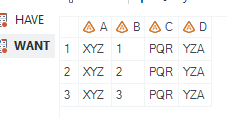- Home
- /
- Programming
- /
- Programming
- /
- Re: Splitting values in a variable
- RSS Feed
- Mark Topic as New
- Mark Topic as Read
- Float this Topic for Current User
- Bookmark
- Subscribe
- Mute
- Printer Friendly Page
- Mark as New
- Bookmark
- Subscribe
- Mute
- RSS Feed
- Permalink
- Report Inappropriate Content
Hi All,
I have a dataset as below with variables A, B, C, D
A B C D
XYZ 1,2,3 PQR YZA
I need output as below
A B C D
XYZ 1 PQR YZA
XYZ 2 PQR YZA
XYZ 3 PQR YZA
Kindly help
Accepted Solutions
- Mark as New
- Bookmark
- Subscribe
- Mute
- RSS Feed
- Permalink
- Report Inappropriate Content
Here one way to go.
data have;
input (A B C D) ($);
datalines;
XYZ 1,2,3 PQR YZA
;
data want(drop=_:);
set have;
_stop=sum(countc(b,','),1);
_b=b;
do _i=1 to _stop;
b=scan(_b,_i);
output;
end;
run;
- Mark as New
- Bookmark
- Subscribe
- Mute
- RSS Feed
- Permalink
- Report Inappropriate Content
Here one way to go.
data have;
input (A B C D) ($);
datalines;
XYZ 1,2,3 PQR YZA
;
data want(drop=_:);
set have;
_stop=sum(countc(b,','),1);
_b=b;
do _i=1 to _stop;
b=scan(_b,_i);
output;
end;
run;
- Mark as New
- Bookmark
- Subscribe
- Mute
- RSS Feed
- Permalink
- Report Inappropriate Content
Also, here's another way to do it.
data have;
input (A B C D) ($);
datalines;
XYZ 1,2,3 PQR YZA
;
data want (drop = bb i);
retain a b c d;
set have (rename = (b = bb));
do i = 1 to countw(bb, ",");
b = scan(bb, i, ",");
output;
end;
run;a b c d XYZ 1 PQR YZA XYZ 2 PQR YZA XYZ 3 PQR YZA
April 27 – 30 | Gaylord Texan | Grapevine, Texas
Registration is open
Walk in ready to learn. Walk out ready to deliver. This is the data and AI conference you can't afford to miss.
Register now and lock in 2025 pricing—just $495!
Learn how use the CAT functions in SAS to join values from multiple variables into a single value.
Find more tutorials on the SAS Users YouTube channel.
SAS Training: Just a Click Away
Ready to level-up your skills? Choose your own adventure.



